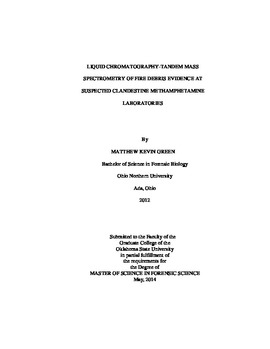| dc.contributor.advisor | Wagner, Jarrad | |
| dc.contributor.author | Green, Matthew Kevin | |
| dc.date.accessioned | 2015-06-17T20:06:04Z | |
| dc.date.available | 2015-06-17T20:06:04Z | |
| dc.date.issued | 2014-05-01 | |
| dc.identifier.uri | https://hdl.handle.net/11244/14858 | |
| dc.description.abstract | The "One-Pot" methamphetamine production method involves the combination and use of highly reactive and flammable materials. Individuals attempting this method are creating clandestine laboratories within residences and other occupied structures, and the likelihood of a subsequent fire puts anyone nearby at risk. In the State of Oklahoma, if the production of methamphetamine causes a fire, the crime falls under the first degree arson statute, which can involve a prison sentence of 35 years, as opposed to 7 years for the production of drugs. The ability to detect methamphetamine and the One-Pot precursors in fire debris would strengthen the arson investigation. One-Pot methamphetamine reactions were carried out and the liquid and solid products were used to recreate a fire. Small burn cells were used to represent a residential environment. Several fire debris sample types were collected, including wall wipe samples, burned bottles, wood, and carpet. Each sample was analyzed for ignitable liquids using headspace extraction and gas chromatography-mass spectrometry (GC/MS). Following arson analysis, liquid chromatography-tandem mass spectrometry (LC-MS/MS) was used to detect methamphetamine and pseudoephedrine, the methamphetamine precursor, in the fire debris. Additionally, fire debris samples were provided to local law enforcement and GC/MS was also able to detect methamphetamine in the fire debris. This work demonstrates that fire debris analysis can prove the presence of clandestine methamphetamine laboratories that result in arson fires. | |
| dc.format | application/pdf | |
| dc.language | en_US | |
| dc.publisher | Oklahoma State University | |
| dc.rights | Copyright is held by the author who has granted the Oklahoma State University Library the non-exclusive right to share this material in its institutional repository. Contact Digital Library Services at lib-dls@okstate.edu or 405-744-9161 for the permission policy on the use, reproduction or distribution of this material. | |
| dc.title | Liquid Chromatography-tandem Mass Spectrometry of Fire Debris Evidence at Suspected Clandestine Methamphetamine Laboratories | |
| dc.type | text | |
| dc.contributor.committeeMember | Allen, Robert W. | |
| dc.contributor.committeeMember | Wallace, David | |
| osu.filename | Green_okstate_0664M_13293.pdf | |
| osu.accesstype | Open Access | |
| dc.description.department | Forensic Sciences | |
| dc.type.genre | Thesis | |
| dc.subject.keywords | arson | |
| dc.subject.keywords | clandestine laboratories | |
| dc.subject.keywords | lc/ms/ms | |
| dc.subject.keywords | methamphetamine | |
| dc.subject.keywords | one-pot | |
| dc.subject.keywords | pseudoephedrine | |
